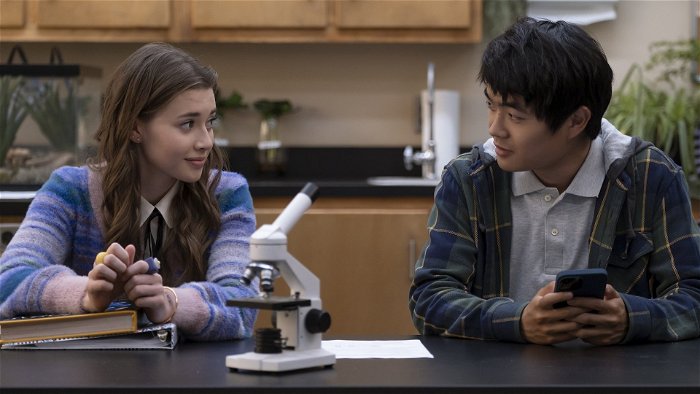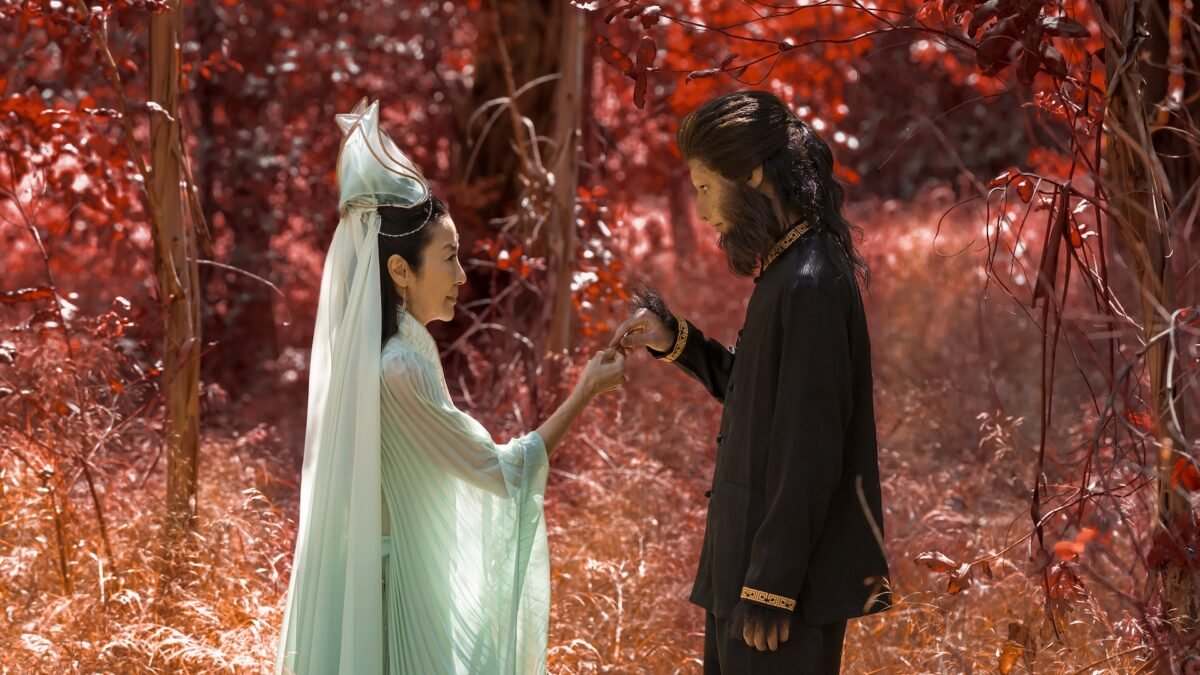In a time where being woke and human connectivity have received more attention in the mainstream world, American Born Chinese thrived on telling a specific folklore tale that comingles with first-world problems. “First-world problems” are typically taken in a condescending afterthought, but it could also be seen as a way to address important issues in first-world countries and address global societal/cultural norms as well—like the importance of what it means to come of age. This was no normal adolescent tale, though.
A graphic novel of the same name was published by Gene Luen Yang in 2006, which told the tale of an American teenager named Jin Wang who struggles to balance his school life, love life and family life—really focusing on the racial climate of Chinese-American communities and culture. It was like a book version of playing through a Persona game.

In the show, the story takes place primarily in two locations: Heaven and a San Francisco-based suburban town called Sierra Mona. Jin’s life is turned upside down mostly by the introduction of a new student, Wei-Chen, who, unbeknownst to him, is the son of the mythological god Sun Wukong—The Monkey King. The rest of Jin’s battle with teenage life and exploring his own identity is half of the story. While I have not read the graphic novel yet, this new series made me order it immediately after.
Some may remember the depictions of Sun Wukong and other Chinese mythological beings from other media and video game formats like League of Legends, Smite, The Forbidden Kingdom and Journey To The West. All of these versions derived from the original novel of The Journey To The West, said to be first published in the late 16th century—and adapted through time.
“The long list of the supporting cast was an amazing sight to see from other Asian-centric films like Shang-Chi and the Legend of the Ten Rings, Crazy Rich Asians, and Turning Red.“
The first aspect that swept me off my feet in American Born Chinese was how much Destin Daniel Cretton and Kelvin Yu were able to bring together big stars as complementary characters to the protagonists. The long list of the supporting cast was an amazing sight to see from other Asian-centric films like Shang-Chi and the Legend of the Ten Rings, Crazy Rich Asians, and Turning Red.

And coming in hot off their Academy Award success, Michelle Yeoh, Ke Huy Quan, Stephanie Hsu and James Hong were back together—in a new way compared to Everything Everywhere All at Once. Of the four of them, Yeoh and Quan were the prominent characters who supported the perfectly cast Ben Wang, who played the role of Jin, and Jimmy Liu, who played Wei-Chen.
Quan played a typecasted 1990s-ish TV sitcom star named Freddy Wong, who was known for his punchline, “What could go Wong,” on a show called Beyond Repair. Without spoiling too much, this example of Asian representation in the media added to a much greater conversation both as it pertained to how Jin grappled with his identity in his school—and American Born Chinese as a show for its viewers. Let us just say it was more transparently connected than Jordan Peele’s Nope storyline with Steven Yeun but less gory (IYKYK!).
I always love when they are able to reference Crouching Tiger Hidden Dragon with its iconic use of wirework. And, of course, they had Yeoh be one of the first to show it off in the series, playing Guanyin, the Goddess of Compassion/Mercy. On the same thread involving wirework, the fights that utilized it were shot intelligently—and not overutilized.

Another core feature of American Born Chinese was its Kung-Fu, action-packed fights. What was most interesting was that there was very little crossover between the fighting and teenage/family life drama, which seems like a typical American TV/film trope where the protagonist learns to fight, and it solves all their problems. Nothing displays that trope better than The Karate Kid and Cobra Kai; I still love those worlds though! I thought this was masterful writing to break this common storytelling characteristic.
“Everything and everywhere, American Born Chinese was nestled with all the conversations at once.”
The fights definitely had that Cretton magic behind the camera because many of them were up-close shots, one-shots that were used in Shang-Chi. The fight choreography felt dynamic and fast-paced, with the camera work making each hit land and adapt to the situation of the fight conditions. This is not surprising with assets like Daniel Wu and Quan on-set, bringing their fight choreography resumes from Into The Badlands, New Police Story and X-Men. Some of the fights even became anime-like, reminiscent of Dragon Ball Z or Bleach—again, this was where they had fun blending fantasy and reality.
The purposeful use of VFX and CGI also stood out to me as not overbearing or trying to force special effects to dazzle but worked to enhance the fights on a grander scale. On a similar note, big credit to the costume and makeup artists, especially in the flashback episode with many of the mythological beings and high-ranking officials.

The colourful palette and intricate depictions of the different Chinese mythological gods were practical and not filled with much post-work. This helped to really sell the emotions of the actors—even though motion capture technology has come far with the likes of characters like Josh Brolin’s Thanos in Avengers: Infinity War.
The set designers for American Born Chinese deserve a big award for the accuracy of Jin’s room design. His room was littered with many references from comics to manga/anime. He had copies of Naruto, Amulet and One Piece—all the sorts of paraphernalia a teen like Jin would have. But what kind of person is Jin? He was definitely that high school friend you could think of who floated around and somewhat got along with all the groups or cliques—can we be done with cliques already?!
“American Born Chinese was a great precedent of commentary and near-perfect representation of Pan-Asian voices—perfect timing with Pan-Asian Heritage Month being in May.”
I definitely felt a connection to this portrayal of Jin because I was pretty much that floating high schooler who also seemed to struggle with my identity at this age. I come from a very mixed background of being half-Filipino and half-Trinidadian, along with being half-class clown and half-anxious-depresso-espresso. Being the kid who sort of fits in everywhere is nice, but eventually, it does have its moments of “pick a side” occasionally. Jin also faced this tribulation as he became a TikTok meme in correlation to the problematic punchline from Beyond Repair.

So, there was action and fantasy…what about the comedy? I would personally like to give credit to the screenwriters and casting director(s) on this show because every single role fit and showed off each actor’s chops. From the parents and adults who were also able to have their spotlight moments to the teenagers who were angsty but not psychotic or generically written as “bad guys,” even the love interest for Jin, Amelia, had a lot more agency and depth. The teenage flirting was almost never cringy as compared to some other shows. Almost every character got their time to shine or have some kind of development.
American Born Chinese was a great precedent of commentary and near-perfect representation of Pan-Asian voices—perfect timing with Pan-Asian Heritage Month being in May. It was also a great human interconnected story that worked well for it raising issues for Mental Health Awareness Month this month as well, as a lot of teens in real life face similar environments in schools (or worse). Everything and everywhere, American Born Chinese was nestled with all the conversations at once.
Despite the social agenda of American Born Chinese, it never felt like it was overbearing—more like an issue was addressed, and the perpetrator would apologize with a better understanding of the conversations. This is truly the kind of coming-of-age show I wish I could have seen growing up, but I am glad it has finally been made for this generation. Hopefully, it will get another season, if possible, as it left me theorizing and teased an interesting direction for the future.






